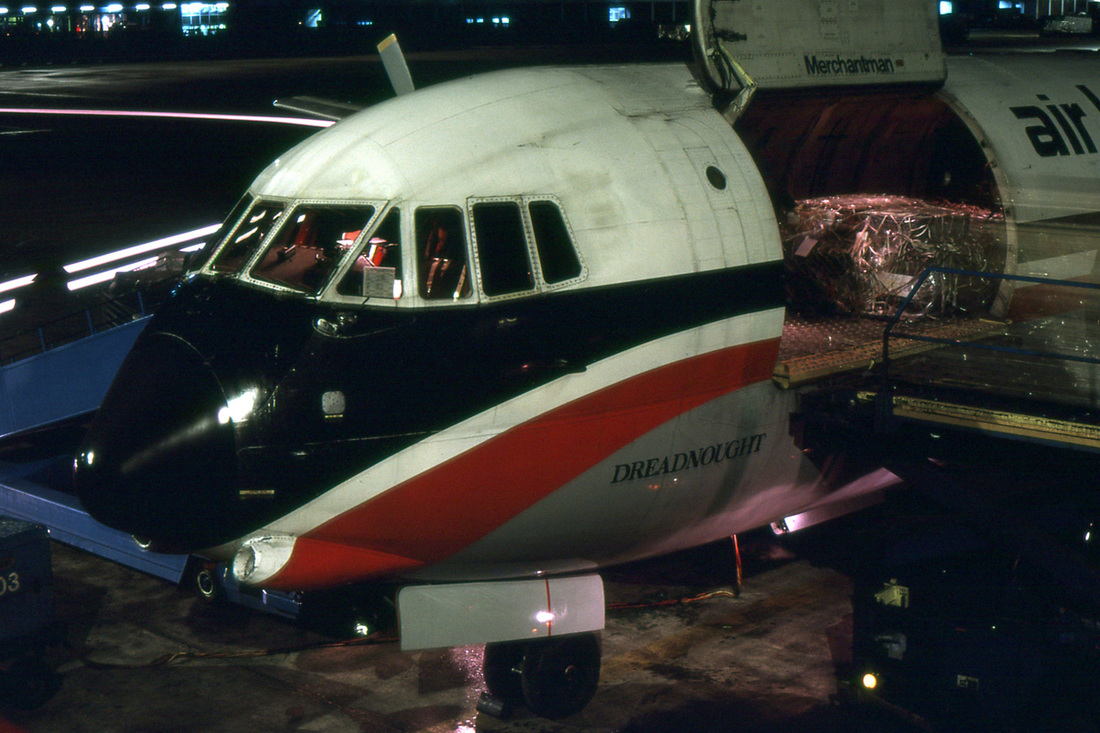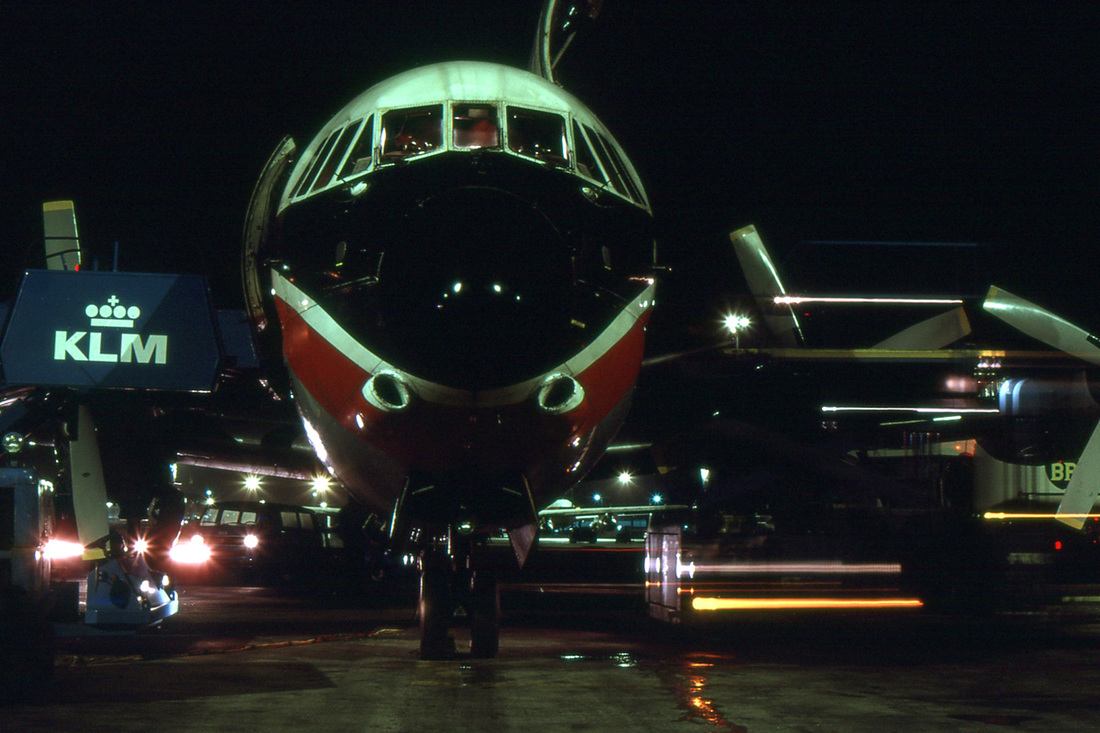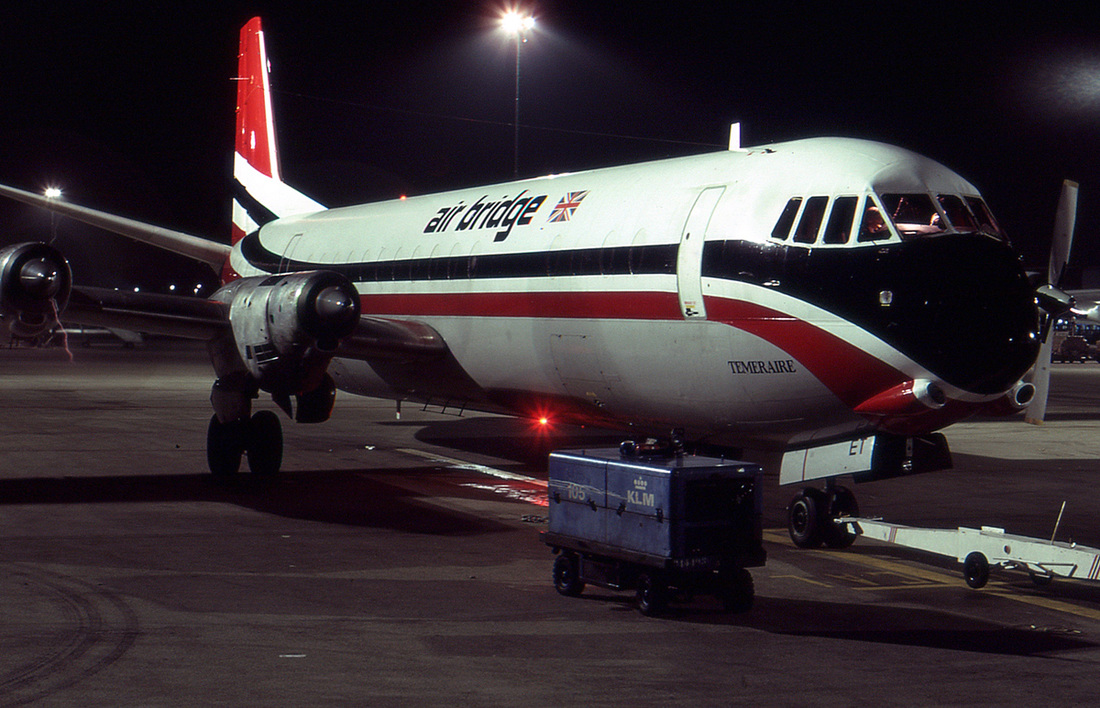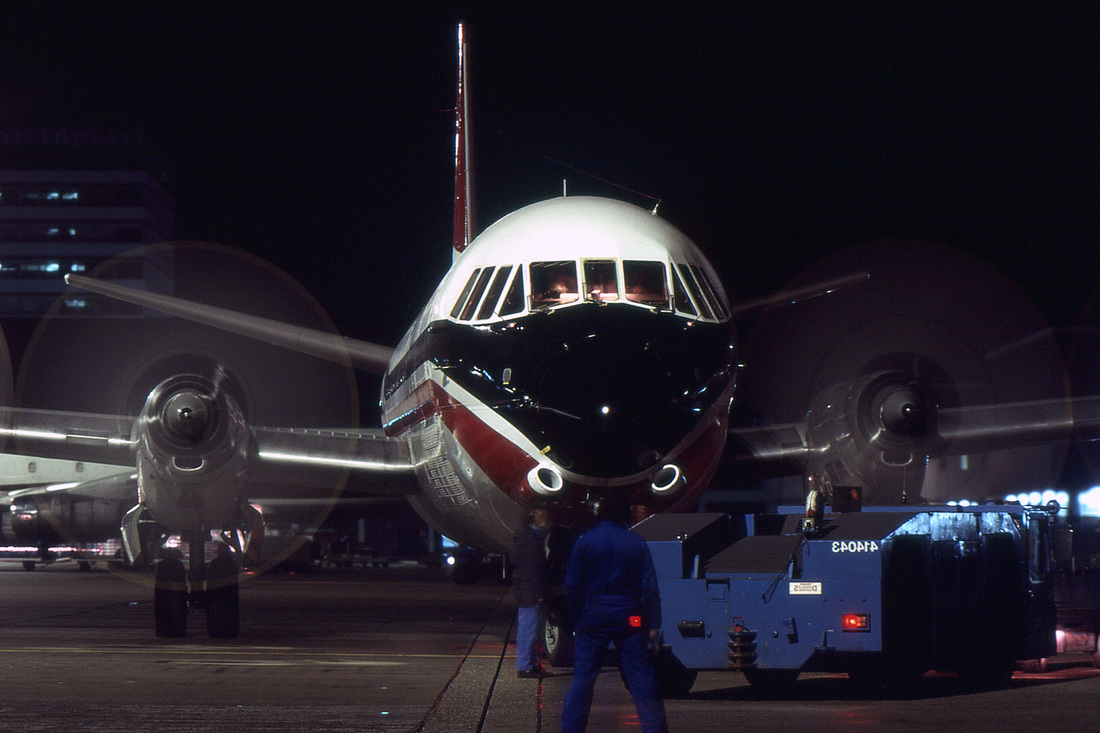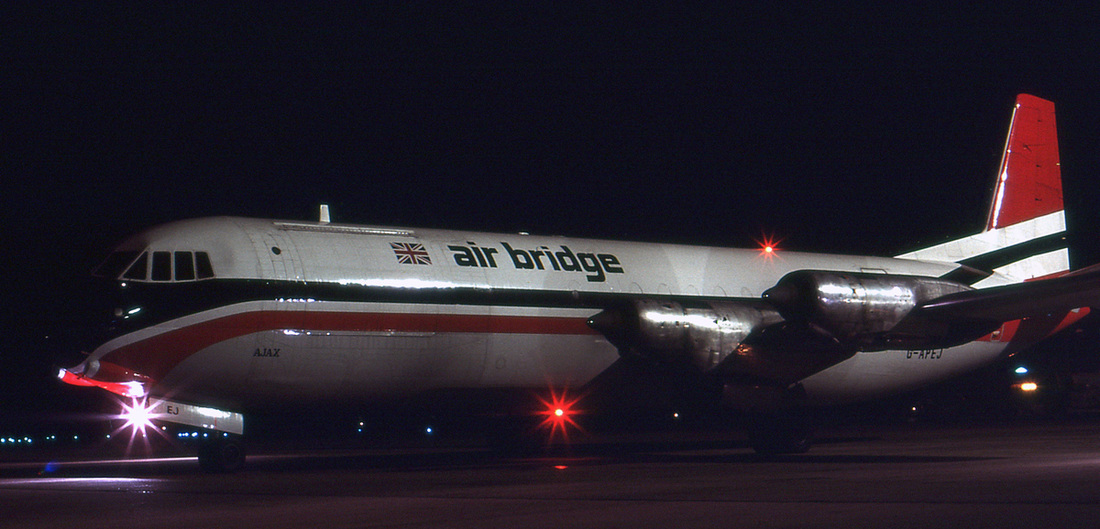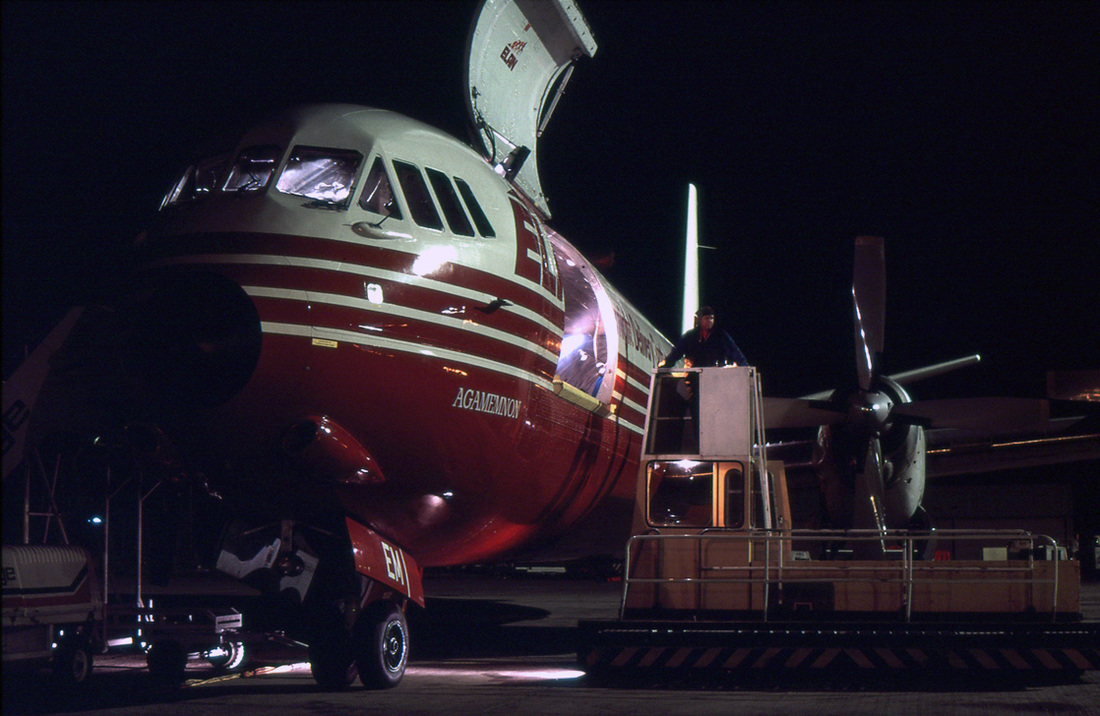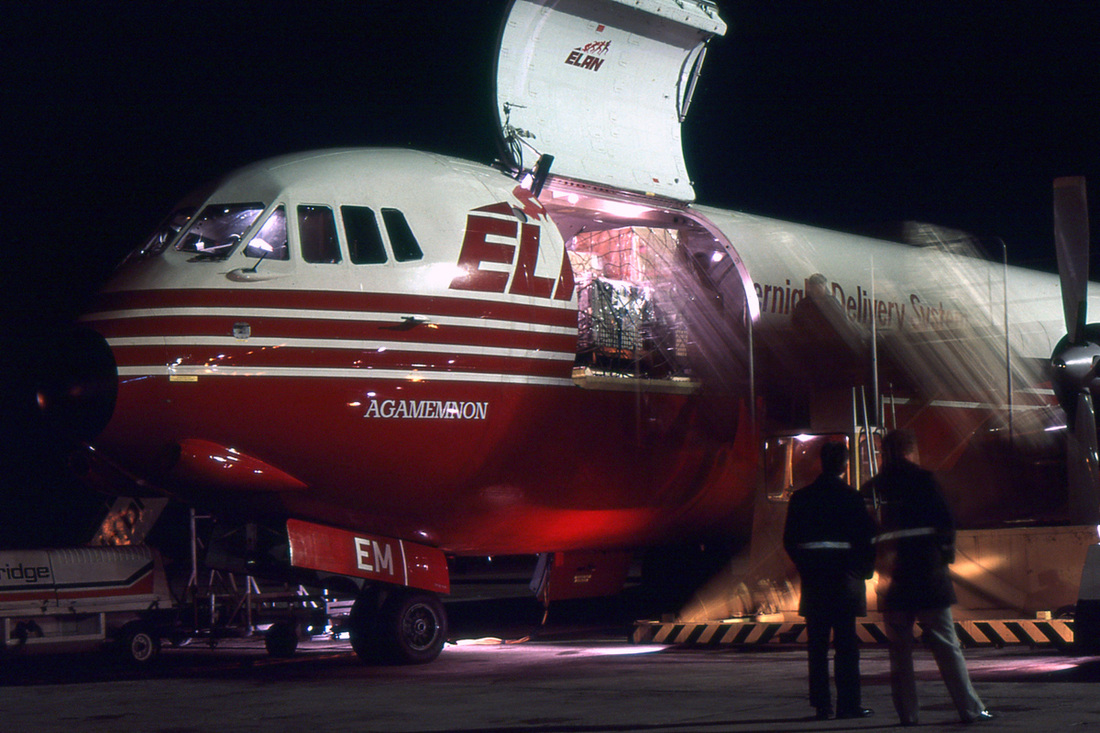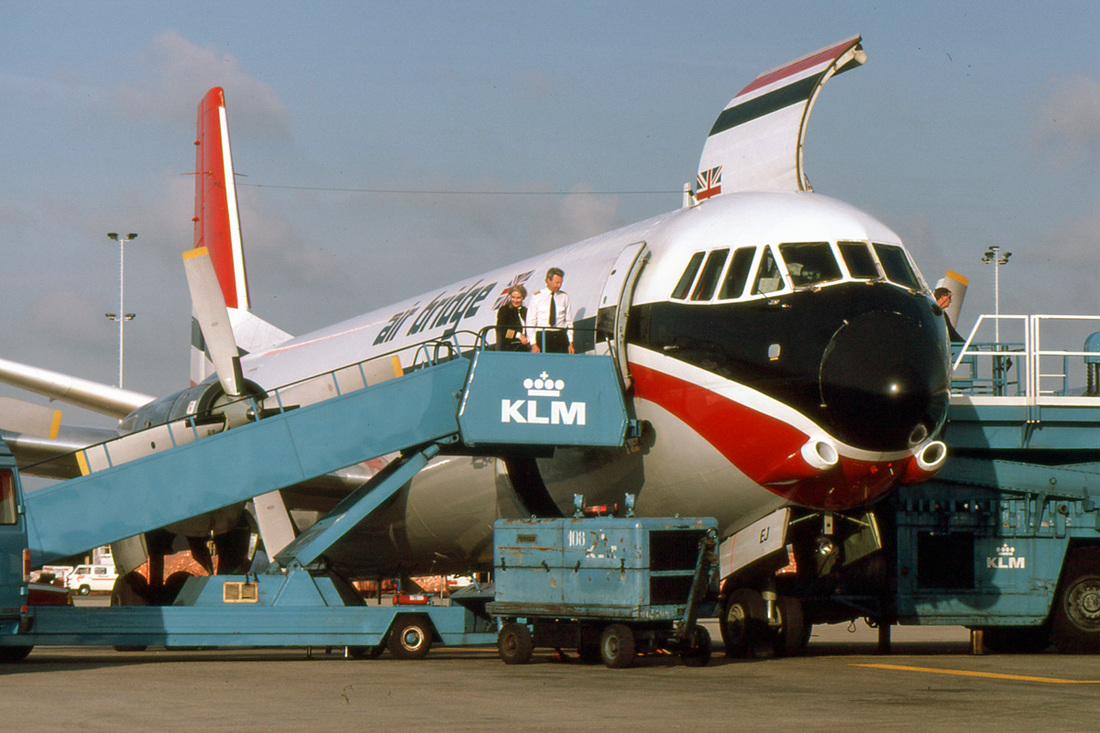BY MERCHANTMAN TO AMSTERDAM
Come aboard for a trip in a rare vintage propeller-driven transport.
By Jan Koppen
|
East Midlands Airport, England, 2000 hours, early December 1987, in preparation of my upcoming flight with Air Bridge, I entered their flight operations room. Outside the weather was dreadful, it was drizzling and patches of thick gray fog slowly drifted across the dimly lit and deserted ramps. Although the nigh was still young, I was surprised by the activity which was going on in this brightly lit room. Two duty officers were performing their duty amid a pile of scattered papers, empty coffee cups and old lunch bags. My attention was caught be the annoying rattling of the telex printer, which looked like it should have been pensioned years ago. I was amazed by the looks of this room. I thought to myself, "Jesus, how is it possible that the strict pace of a 24-hour airline operation is made amid such a mess!".
He introduced himself as Captain West I settled down in a quiet corner of the room and waited for the flight crew. Meanwhile I decided to enjoy a cup of coffee and walked over the coffeepot. With lots of sugar, the bitter extract tasted okay! Five minutes later, a slim, pale faced man, wearing a creased flasher trench coat, entered the room. He walked to the flight plan cabinet and glanced at the flight papers. To my astonishment he appeared to be the First Officer of my upcoming flight!. Moments later, a well-dressed man in a black flight suit, flanked by "four shining golden stripes" on the tips of his shoulder, entered the decrepit office. He approached me and introduced himself as Captain Ken West. Commander of flight ABK220, from Manchester to Amsterdam. Immediately after the introduction, West was informed about the weather condition at Amsterdam - which appeared even worse than here at East Midlands. Amsterdam reported a mere 1500 feet visibility, not enough to land a Merchantman. But the report also indicated that the weather was improving. Around nine o'clock, Captain West, F/O Berry and myself jumped into a company taxi and drove off to Manchester International Airport, in the pouring rain (This was the standard practice for Air Bridge departures from Manchester). During the taxi ride, I got better acquainted with the flight crew. Berry, seated in the left-hand corner crawled into his over-sized trench coat and dozed off! With Commander West, who lit up one of his expensive filter cigarettes (Yes... this was still possible in the 80s), I managed to get a more interesting conversation. During his military career, with the Royal Air Force, West accumulated thousands of hours as a V-class bomber pilot. He also gained a lot of turboprop experience in various parts of the world, such as Sarawak, Malaysia and Lago, Nigeria - flying the Bristow Masayu Bell 205 and the Aerocontractors DHC-6 Twin Otters, respectively. West felt it an honor to fly the British Vickers Vanguard (modified to Merchantman cargo configuration), a vintage transport which still went strong in the 80s world of jet supremacy. Arrival at Manchester After one and an half hour, we finally reached Manchester. The rain was still pouring down while the taxi drove us straight to the freight buildings. We tumbled out of the taxi and ventured through the maze of dull corridors. Finally we reached the cozy and comfortable Air Bridge crew room. The incoming crew of the Belfast - Manchester run was already present and enjoying the beverages, supplied by Trusthouse Forte catering service. As we entered we were warmly greeted. One half of the crew was relaxing in front of the TV set, enjoying a boxing game, while the other was nipping his pipe. West immediately checked on the Amsterdam weather conditions.... unfortunately, still no change. He opted not to depart and delayed the flight. His colleagues remarked jokingly about his decision and were teasing him a little bit. But West knew better and kept his cool! During the handover, the previous crew also commented on some of the minor technical snags which burdened our outbound aircraft, registrated G-APEJ and named Ajax. It appeared that the LH window wiper was not working properly, cockpit pressure wasn't steady at a certain height and the co-pilot's headset didn't function as it should .... otherwise our pristine veteran was in mint condition! After hearing all this, Berry appeared from behind his gossip newspaper, with a heavy sigh, "Gee guys, do we really have to go?". During our lengthy delay, which caused some boredom, the subject of conversation changed drastically from serious aviation safety matters, to hot topics such as a good game of golf, a bottle of scotch and attractive cabin attendants of the female species. After numerous phone calls with Amsterdam-Meteo and KLM flight operations, West finally decided to prepare the aircraft for departure. He grabbed his flight plans, and we made our way to the brightly lit ramp on which our Merchantman shared the space with a lone Tradewinds 707. A hive of activity surrounded the pristine Vickers as she was being readied for her upcoming flight. By Merchantman to Amsterdam I accompanied West during his walk around inspection, which gave me a chance to get a closer look at the Merchantman. Our spotless aircraft had a smart red, white and black livery, with large Air Bridge titles set on both sides of her fuselage. Her wing, to which four Rolls-Royce Tyne 512s are attached, spans 118 feet and 5 inches. The rudder, 34 feet and 9 inches high, towers over the nearby office buildings. The aircraft was already loaded and we could hear the squeaking sounds, combing through the hull, from our lively load of 10,000 one-day chicks. "She looks fine to me! What do you think Jan?" I agreed with Captain West and accompanied him to the spacious flight deck where F/O Berry just finished the pretake-off checks. While the forward RH entrance door was being closed, I strapped myself into the jump seat. Perched in between the two confident pilots, I gazed at the instrument console, which was crammed by many switches, levers, red and white warning lights. Despite the usual cockpit defects, West detected a faulty switch on the overhead panel. Annoyed by all this, he remarked, "Besides flying this old thing, we have to fix her too". What do you expect from a 27-year-old aircraft! F/O Berry requested our start-up clearance which was granted instantly by Ground Control. Our designated call-sign was "AirBridge-220". With a flip of the starter switch, located on the overhead panel, engine number three, good for 5050 shp, started to awaken and settled down to an incessant whine. Numbers four, one and two were started respectively in sequence. With all four "up and running very sweetly". West released the parking brake and informed the ground engineer that "Echo-Juliette" was ready for pushback. While the heavy-laden Merchantman was being positioned for disconnection of the tug, a crackling message through our headsets granted us taxi clearance for runway 06. Moment later the ground engineer was signaling us, with the familiar thumbs-up, indicating that "Echo-Juliette" was free from the tug. Captain West eased the big throttle levers forward and slowly the aircraft started to move. With all four Tynes humming safely, we taxied past the tail of the Tradewinds 707, and soon we were navigating through the maze of green and blue lights of Manchester taxiways. During our taxi, the windshield wipers were turned on max in order to keep the windows water-free. As I prepared for the departure, Berry turned around and asked if we could switch headsets. "It's okay with me", I replied. Later I was to understand his request, he handed me the faulty headset! As we were taxiing to the runway holding point, we watched as an incoming Brittania Boeing 767-200, with a full load of sunburned tourists from the sunny Mediterranean, glided past us and touched down on the wet runway. Upon the holding point, West stopped the Merchantman with a gentle touch on the brakes. With a reassuring look, he studied his instruments and checked his partner. All was working perfectly, and we were set to go. With takeoff clearance granted, West turned the Merchantman onto the active and pushed all four throttles forward for maximum engine thrust. With the increased high pitched whine of the four Tyne engines coming through the fuselage. "Echo-Juliette" started to move forward and shook violently. As we gathered speed, I watched the airspeed indicator increasing, and we quickly reached rotation speed. Berry said "V1", indicating that the Merchantman's speed was safe to initiate rotation. Seconds later, the Merchantman shifted up into the air and safely climbed way, tucking up her wheels. With a graceful left turn over the sleeping city of Manchester, we started our ascent to cruising altitude. The Merchantman picked up the Ottringham beacon as we tracked an easterly course, enabling us to reach the European mainland. As the flight progressed, I got a chance to relax and lay back a little. The Merchantman flies well and it was hard to believe that I was flying a typical British-built early 1950s design. The Vickers V953C The Vickers V953C Merchantman, which is the modified cargo version of the Vanguard, first flew on 20 January 1959. The aircraft was basically designed as a replacement for the highly successful Vickers Viscount. Resulting from British European Airways and Trans-Canada Airlines requirements for an airliner somewhat larger than the Viscount, with superior operating economics and performance to enter service in 1959, the Vanguard fitted their requirements perfectly. the first Vanguard for BEA entered scheduled service on 1 March 1961, while Trans-Canada Airlines started their service one month earlier. The Vanguard's performance in general was all that could be asked for in a turboprop design of the late 1950s. Unfortunately only 44 Vanguards were built. Despite Vickers's effort to secure further orders, none were forthcoming as at that time the airlines had a fixation on buying the latest pure jet airliners. By October 1968, the limited success of the Vanguard for passenger operations persuaded BEA to start converting its aircraft to an all-freight configuration, with the new name Merchantman. The conversion was carried out by Aviation Traders which included mainly the installation of a large freight door on the left side of the forward fuselage and a fully palletized interior which offered a generous payload of 18.5 tons. A reliable power plant in the shape of four Rolls-Royce Tyne 512 engines, each delivering 5050 shp, made the V953C a fuel-efficient aircraft, capable of cruising at a speed up to 400 mph. During the 1970s, large numbers of Vanguard/Merchantman were operated by companies such as EAS of France, Merpati Nusantara Airlines of Indonesia and British Airways Cargo of Great Britain. Unfortunately, in the second half of the 1980s her numbers had dwindled dramatically. The reasons for the success of the Merchantman operations in the world of jet technology were her impressive payload, economic operation and the ability to comply with the 1980s strict noise restrictions. Air Bridge, which was based at Castle Downington, East Midlands, flew a fleet of six Merchantman’s. Air Bridge which started under the name Air Bridge Carriers, was set up in 1972 by Fields Aviation, part of the Hunting Group of Companies, to operate freighter aircraft between the Channel Islands and East Midlands. During the first year, four Argosies were used to do the job. 1974 saw the addition of a new type, the Viscount freighter, which supplemented on the thinner cargo routes. Two years later, the Merchantman saw service with Air Bridge Carriers. She was used mainly for the carrying of bloodstock. Subsequently several other Merchantman’s were acquired during the following years. In 1980, the company adopted the trading name Air Bridge along with a striking new red, white and black color scheme in a more up-to-date style. In 1983, Elan, the Overnight Delivery System, a subsidiary of the huge DHL courier organization, set up their express parcels service and used Air Bridge aircraft as their transport medium. By early 1984, express parcel flights had become the major proportion of the Air Bridge fleet work. November 1986 saw the commencement of Air Bridge Merchantmen’s operating cargo flight to Amsterdam out of several European City's on behalf of the KLM. Amsterdam arrival While cruising at 20,000 feet under the star-filled sky, we passed the halfway mark without trouble. Soon after, we were handed over the Dutch Air Traffic Control. I was starting to feel a bit fatigued, as I hadn't slept properly for the last two days. With 43 minutes into the flight, ATC broke the silence on the flight deck and advised us of our descent clearance. West selected Amsterdam weather information for the latest weather report.... unfortunately, it was still bad! With the Merchantman's throttles eased back and the aircraft in a nose-down attitude, we were losing height quickly. Flickering lights were visible through the cloud cover, indicating that we were approaching the Dutch coastline. As we made a gradual right turn, we started to skirt through the upper levels of a dark cumulus. As "Echo-Juliette" stared to buffer for a moment, I adjusted my seat belt. The Dutch coastline was crossed at 5,000 feet, and following heading and speed instructions from Amsterdam, we were soon being vectored for an ILS approach to runway 06. Everything started to happen very quickly, as West selected more flaps and reduced engine power. The sturdy old Merchantman was descending through the clouds rapidly. As we passed over the outer marker, West selected gear-down and we watched the three gear lights turn amber, indicating that the undercarriage was in transition. With three green lights showing brightly on the center console, I started to feel a bit more comfortable knowing that the gear was firmly down and locked. I looked across West's shoulder through the forward windscreen and I still couldn't see anything familiar. The fog was still obscuring our vision. I checked the altimeter which indicated that we were just a couple of hundred feet above ground. At that same time, Berry remarked, "Gee Skipper, where the hell is that bloody runway?". As soon as he made his irritating remark, the Merchantman broke through the fogbank, and we were struck by the bright lights of the illuminated runway, which lay in front of us. The gray belly of the Merchantman ghostly lit by the overwhelming light, shot past the threshold. West realized that his aircraft was too high and pushed the yoke forward instantly. The Merchantman nosed-downward in order to reach the correct glide-slope angle for a correct touch-down point. With this sudden correction, West couldn't prevent the aircraft from touching down halfway down the runway. As soon as Echo-Juliette's wheels touched down firmly, the aircraft's massive Hamilton propellers were put into revers pitch, slowing the aircraft down to a safe taxi speed. We left runway 06 and backtracked on the parallel inner taxiway, which brought us to Eco Juliette's familiar parking spot on freight apron 3. As we followed the yellow marshal truck up to the freight ramp, we were met by a bunch of tired ground loaders eagerly awaiting to unload this delayed "veteran workhorse" on her early morning schedule. The End |
The Vanguard grew out of the Vickers Viscount which had been very successful aeroplane for BEA, but by the early 1960s was getting a bit small. BEA had asked Vickers for a stretched model, but it quickly became obvious that the new Rolls Royce Tyne engine with nearly two and a half times the power of the Dart that powered the Viscount was the obvious choice of engine and that led to a much bigger aircraft. More than twice as big. It was also much faster with a typical cruise speed of just under 350 knots. It was one of the fastest turbo-props ever built with only the Tu 114 being very much faster.
The aircraft, spotless considering its contant use,initially flew for BEA.
The massive ram air intakers under the nose for the cabin conditioning and the taxi-light between the nosewheeldoors.
The Vanguard is a Big aeroplane; a dominating 34 feet in tall, 122 feet long and with a wing span of over 118 feet.
The flying controls were all manual with no power assistance. As you may image the control surfaces were very big and some assistance was given by spring tabs, a sort of trim tab, but connected into the control circuit. The controls were locked with mechanical locks at all time on the ground and only unlocked when the aircraft was lined up for take-off. On landing the controls were locked again at 80 knots otherwise they would thrash around in the prop wash.
The flying controls were all manual, although they all had fairly powerful spring tabs to ease the load. This was on an aircraft with a maximum weight just short of 70 tonnes and a maximum speed not far short of 400 knots. The wing loading was also very high, certainly much the same as modern jets giving speeds on the approach of around 130 knots. Flapless approach speed was 165knots. It had massive slotted flaps.
Heavy laden G-APEJ 'Ajax' four Rolls Royce Tyne 512's are 'up and spinning very seewtly' and are ready to fulfille another round-trip on Amsterdam - East Midlands cargo schedule.
The 5000 hp “Mighty Tynes” meant it was quite overpowered for its time and it had an unbelievable amount of reverse thrust. The reverse thrust was very rarely used in service with “Ground Idle” being quite enough to slow the aircraft. If full reverse was used with maximum wheel braking it was quite possible to get a stop of over 1 G with everything not nailed down ending up in the cockpit.
The Mighty Tynes at taxi power.
There were various attempts at syncrophasing the propellers, that is not only synchronising the speed, but also making sure that the blades of two adjacent props were kept 45 degrees apart to reduce noise and vibration. The idea was good, but alas the mechanical control of the props was just not up to it and things continued to rattle and roll around for the life of the aircraft.
The fuselage was wide enough at deck level for six abreast seating. The fuselage was made bigger still by making it a “double-bubble” or figure of eight shape that allowed very large cargo holds. This fuselage shape and cross section was also used in the jet VC10 that came later.
G-APEM 'Agamennon' unloading at Castle Donington - East Midlands.
|

